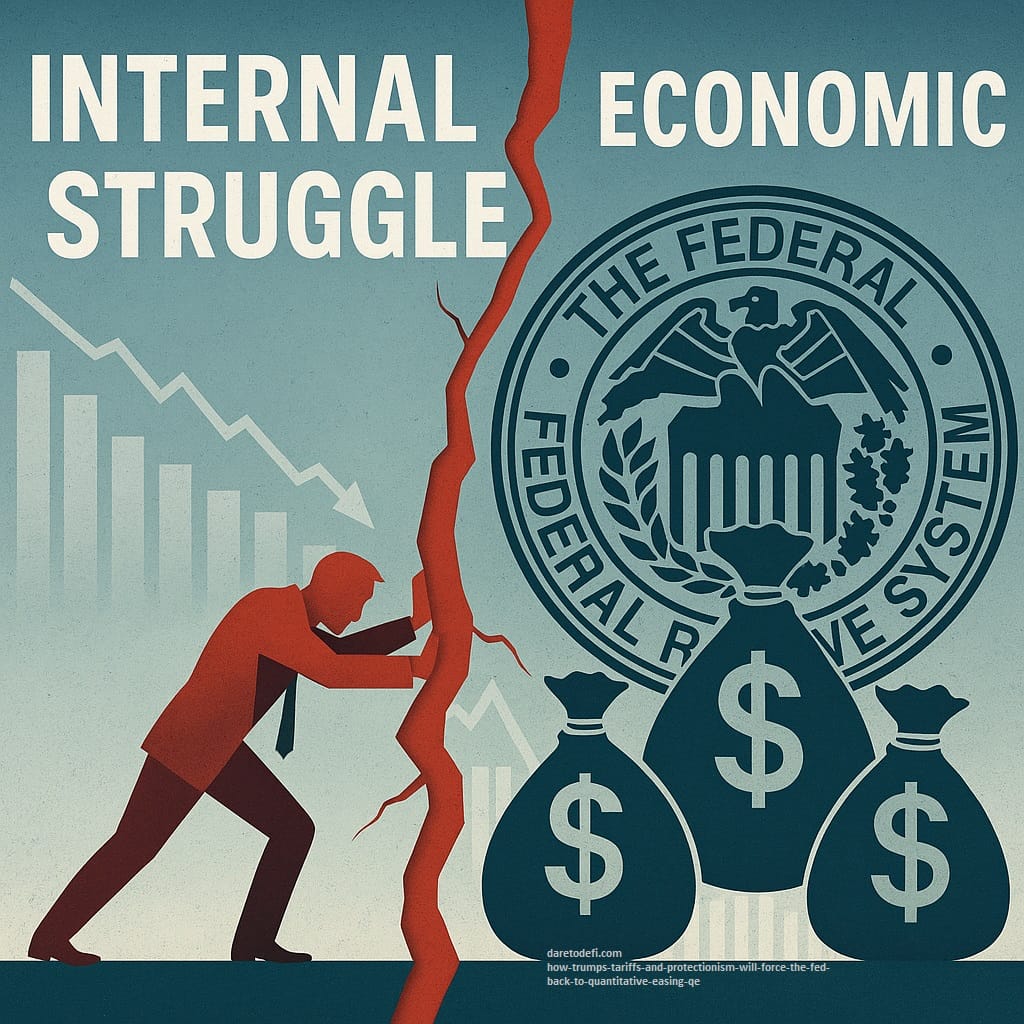How Trump's Tariffs and Protectionism Will Force the Fed Back to Quantitative Easing
Trump's tariffs and protectionist trade policies are reshaping global finance. Discover how these policies limit who buys U.S. debt, why this creates a major economic dilemma, and why it will likely push the Federal Reserve back into Quantitative Easing (QE) sooner rather than later.

President Trump’s policy of economic protectionism, aimed at boosting domestic manufacturing and employment, directly impacts the Federal Reserve’s monetary policy, specifically necessitating the restart of Quantitative Easing (QE). Understanding this complex relationship involves examining several key elements clearly and comprehensively.
Trump's Protectionist Economic Policy
Trump’s central goal is revitalizing U.S. manufacturing to provide good jobs for the 65% of Americans without college degrees, strengthen national security by ensuring weapons and critical supplies are produced domestically, and sustain robust economic growth around 3% annually (real GDP growth, adjusted for inflation).
How Protectionism Impacts U.S. Debt
Historically, countries like China accumulated substantial dollars from trading surpluses with the U.S. These surplus dollars were typically reinvested into U.S. government debt (Treasury bonds) and stocks, effectively financing America's growing deficits. Trump's policies aim to reduce imports, meaning fewer dollars flow overseas. Consequently, these countries now have fewer dollars to invest in U.S. Treasuries, challenging America's traditional funding source.
The Debt Challenge and Economic Growth
America currently has a national debt of approximately $36 trillion and persistently runs annual deficits (the gap between government revenue and spending). Trump's administration targets to reduce this annual deficit from around 7% of GDP today to approximately 3% by 2028. Even with this reduction, the government remains a net borrower each year, increasing the total debt burden.
Economic theory shows that debt becomes manageable if economic growth (GDP growth plus inflation) exceeds the growth rate of debt itself. If America achieves 3% real GDP growth and inflation averages around 2%, nominal GDP growth (real growth plus inflation) would be about 5%. Borrowing new debt at a slower pace (3% annually) can lower the debt-to-GDP ratio over time, making the overall debt burden manageable.
Interest Rates: The Critical Link
The catch is the interest rate on newly issued debt. Typically, investors demand interest rates at least equal to the growth rate of the economy (around 5% in this scenario). Currently, however, the U.S. Treasury pays around 3.28% interest on its debts. A significant rise in interest rates toward 5% would dramatically increase the government's borrowing costs, exacerbating the deficit rather than helping control it.
Who Will Buy U.S. Debt?
Under protectionist policies:
- Foreign investors (like China): Less willing or able to buy U.S. debt due to reduced trade surpluses and political tensions.
- Private investors: Demand higher yields (interest rates), making low-interest U.S. bonds unattractive.
This situation leaves primarily:
- U.S. commercial banks: Currently constrained by regulations.
- The Federal Reserve: The only buyer with unlimited capacity to purchase debt by creating new money.
Why the Fed Must Implement Quantitative Easing (QE)
Currently, the Fed is pursuing Quantitative Tightening (QT), reducing its bond holdings, to lower inflation. Moreover, after the 2008 financial crisis, regulations (Supplementary Leverage Ratio - SLR) restricted banks from buying unlimited Treasury bonds to prevent excessive leverage.
However, if traditional buyers disappear, the Fed will be forced to step in and finance government debt through QE, creating money to buy bonds directly. Additionally, the Fed can relax bank regulations (SLR), allowing banks greater freedom to buy bonds and support Treasury financing.
Historical Precedents
Historically, central banks often accommodate government financing needs despite inflationary risks. In the 1970s, Fed Chairman Arthur Burns allowed monetary policy to remain loose, fueling inflation but supporting fiscal spending. Even Paul Volcker, famous for aggressively fighting inflation in the early 1980s, eventually eased monetary policy under political pressures.
From Burns to Powell: The Lingering Impact of Tariffs and Protectionism on Central Banking
Arthur Burns's "The Anguish of Central Banking" (1979) provides crucial insights into why central banks struggle to control inflation, even when that is their primary mandate. Burns identified a fundamental problem: political pressures and societal expectations often undermine the ability of central banks to maintain price stability.
Burns argued that the issue is rooted in broader cultural and political shifts rather than mere economic policy errors. Historically, Americans valued self-reliance and minimal government intervention. However, the Great Depression shattered this belief, prompting citizens to look to the government for economic assistance. This shift in expectations laid the groundwork for extensive government involvement in the economy through the New Deal of the 1930s and expanded further following World War II.
By the 1960s and 1970s, Americans increasingly expected continual economic improvement, social justice, and comprehensive government support. Politicians, in turn, pursued policies to satisfy these expectations, often at the expense of monetary stability. Persistent budget deficits and fiscal expansions became normalized as policymakers prioritized full employment and economic growth over controlling inflation. The belief that inflation was a temporary and manageable problem led to the dismissal of long-term inflation risks.
Burns emphasized that central banks, despite being officially independent, are heavily influenced by political and societal pressures. While central banks possess powerful tools to curb inflation (such as raising interest rates and restricting money supply), using them is politically unpopular because it can cause economic slowdowns and higher unemployment. This reluctance to take harsh measures allowed inflation to become entrenched.
The most critical point Burns made was that inflation becomes self-sustaining when people begin to expect continuous price increases. Businesses raise prices preemptively, and workers demand higher wages to keep pace, creating a feedback loop that makes controlling inflation even harder. This "inflationary psychology" is difficult to reverse without causing significant economic disruption.
Burns concluded that central banks alone cannot effectively solve the problem of persistent inflation. Instead, he argued, societies must alter their political and economic priorities. Governments need to commit to balanced budgets, reduce unnecessary regulation, maintain strict monetary policy, and provide incentives to boost productivity through well-designed tax reforms. Only when political leaders are willing to accept the temporary pain of tighter monetary policies will inflation be brought under control.
Relevance to Powell’s Federal Reserve
Jerome Powell’s Fed faces challenges similar to those Burns described. Under Trump's protectionist policies and tariffs, foreign investors like China are less likely to purchase U.S. debt. Without these traditional buyers, the burden of financing government deficits increasingly falls on domestic buyers, mainly commercial banks and the Federal Reserve itself.
Much like Burns described, Powell’s Fed faces political and economic pressure to maintain economic growth and employment while trying to combat inflation. But with the added difficulty of reduced global demand for U.S. debt due to protectionist policies, the Fed’s role becomes more complicated. As foreign buyers diminish, the Fed may be forced to restart QE to maintain liquidity and meet government financing needs.
Burns’s insights are particularly relevant today because the same cycle of "inflationary psychology" and political pressure that undermined effective monetary policy in the 1970s remains a critical issue. With Trump’s tariffs reducing foreign demand for U.S. debt and fiscal dominance pressuring the Fed to intervene, the lessons from Burns's era remain as vital as ever.
Conclusion: Fiscal Dominance and QE
Trump's protectionist agenda, including tariffs and reshoring policies, drastically alters the traditional mechanisms of U.S. debt financing. As foreign investors retreat from U.S. Treasuries, the Federal Reserve faces increasing pressure to fill the gap, especially if private investors demand higher yields than the government can afford.
Historically, political realities and the necessity to maintain manageable borrowing costs have forced central banks like the Fed into fiscal dominance, where political and fiscal priorities overshadow the central bank’s ability to independently manage inflation. Arthur Burns warned about this dynamic, emphasizing how inflationary expectations become entrenched when political pressures prevent central banks from taking decisive action.
Today’s Takeaways & Tangible Outcomes to Watch:
- The Return of QE: If foreign buyers continue to reduce their purchases of U.S. debt, watch for the Fed to halt QT (Quantitative Tightening) and reintroduce QE (Quantitative Easing) to maintain liquidity. This would be a clear sign of fiscal dominance.
- Regulatory Easing for Banks: Pay attention to potential adjustments in the Supplementary Leverage Ratio (SLR), which would allow banks to buy more treasuries with increased leverage, another form of QE.
- Rising Debt-to-GDP Ratio: As the government continues to run deficits, monitor the debt-to-GDP ratio. If it continues climbing without corresponding economic growth, expect increased pressure on the Fed to intervene.
- Inflation Persistence: Burns’s "inflationary psychology" remains relevant today. Continued high inflation, especially if coupled with rising interest rates, will create an environment where the Fed is compelled to act to prevent broader economic disruption.
- Fed Communications: Carefully analyze the language and tone from Jerome Powell and other Fed officials. Hints of resuming QE or other accommodative policies will be signals that fiscal dominance is taking hold.
Ultimately, protectionism doesn’t just reshape global trade, it transforms how monetary policy operates within the United States. By limiting foreign buyers of U.S. debt, Trump's policies could force the Fed to adopt increasingly aggressive monetary interventions. The question is not if the Fed will act, but when and how decisively. Time will tell, but the patterns of the past suggest a familiar outcome is near.
